- exemption or immunity from punishment or recrimination
- exemption or immunity from unpleasant consequences
Connecting the dots between police violence, gentrification and dramatic housing price inflation, and the new Gilded Age’s kleptocratic elite…
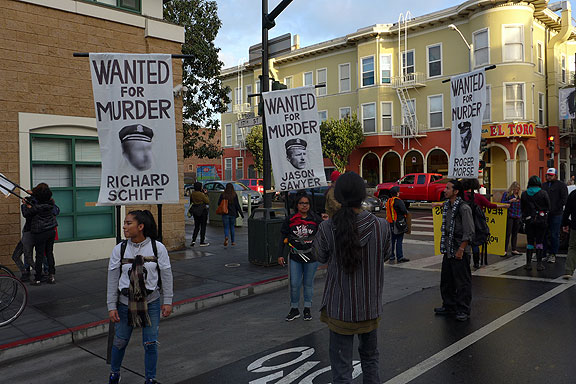
The four police who murdered Alex Nieto on March 21, 2014 were finally named earlier this year after months of obstruction by Police Chief Greg Suhr. Monday March 23 saw over a hundred protesters blockade the Mission Police Station AND an ebay shuttle bus to commemorate the one-year anniversary of Nieto’s death, and to continue to push for justice in this and a half dozen other cases of police murder.
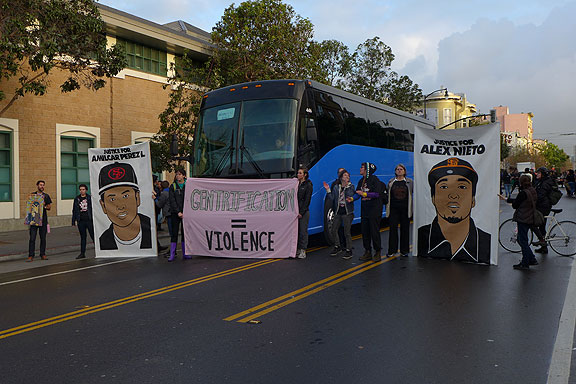
The ebay shuttle bus, blockaded in front of the Mission Police Station on Monday morning March 23, 2015.
Hardly a day goes by anymore that I don’t get news about another young person gunned down by the police, nearby in San Francisco, or in some other city or suburb elsewhere. Nor does a day go by when we don’t hear about another longtime resident or small business being displaced through breathtakingly brazen rent increases or outright fraud. And as each day of this current credit bubble ticks on, we’re that much closer to the next collapse, the next “this came out of nowhere! Who had any idea it was all so fragile?!?” empty economy unraveling.
Meanwhile, highrises are climbing to the sky in most major cities… “Vertical money” or “safe deposit boxes in the sky” is how Martin Filler put it in his recent essay in the New York Review of Books (“New York: Conspicuous Construction”). Comparing the highrises in Manhattan to the contemporary art market, Filler notes that “multimillion dollar paintings and sculptures have become favored instruments in the global transfer of vast and largely unregulated sums. The more expensive the object, the more money can be shifted internationally in one transaction…” The displacement and disruption being caused by the inexorable climb in real estate values (and floor heights, these days!) is a symptom of the extreme concentration of wealth that has accelerated during the neoliberal period of the past quarter century. Driving the mind-boggling speculation in real estate in most major cities is the enormous wealth in few hands which needs a safe place to “land”—and that turns out to be literally land!
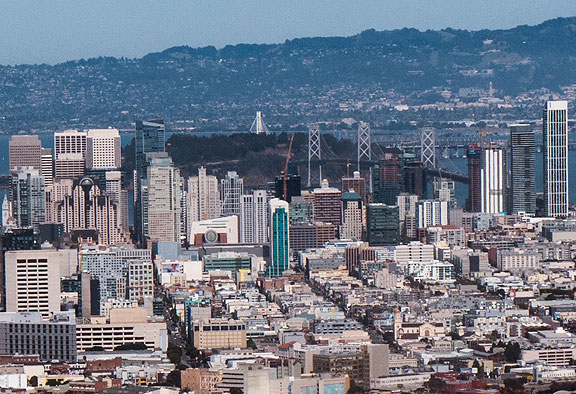
Rincon Hill and South of Market are being built out with highrise luxury condominiums and more redundant office towers.
In 1840, Pierre-Joseph Proudhon famously said “property is theft” but no one could have imagined just how extreme the organized crime underlying today’s international kleptocratic class of plutocrats would be. How does this fit with the everyday state violence being unleashed all too regularly in American cities? The polite term is gentrification but it ought to be labeled for what it is: ethnic cleansing. Americans wring their hands over such activities in other parts of the world, but carry on living in an extremely segregated society. Even in San Francisco, a city that prides itself on a usually undeserved reputation for social liberalism and tolerance, the patterns of police violence are unmistakeable.
San Francisco police kill black, brown, and poor people. The terror inflicted by the police on undocumented immigrants (and those that “look like them”) flies in the face of official city policy to serve as a sanctuary city for such folks. Decades of harassment against Latino youth has produced a bloody legacy of death, imprisonment, and ruined lives. San Francisco’s black population once topped 100,000 people, about 1/7 of the city in 1970. Today it is down to less than 40,000 and is falling steadily. Median incomes in the formerly African American Fillmore district, and the Mission district where Latinos have concentrated since the early 1960s have soared past $100K per year. The rich are moving in, and the police are making sure the poor and working class know they should “move on.”
The pattern of impunity when it comes to police murder is sickeningly consistent: Police shoot and kill an unarmed person, usually black or latino, and quickly follow the well-established public relations campaign their unions and commanders have taught them to pursue. 1) Defame the victim as (choose one or several): a known danger, a dangerously unstable mentally ill person who was acting erratically, a long-term criminal, a violent psychopath, a drug abuser; 2) Claim their safety was threatened, that they had to shoot to defend their lives. Once these two pillars of police murder are made public, the news media dutifully repeats them before any actual investigation of the circumstances has taken place. In the public consciousness, another person who was “threatening public safety” has been killed by valiant police, the thin blue line between order and chaos, normal life and a plunge into the abyss of murderous mayhem.
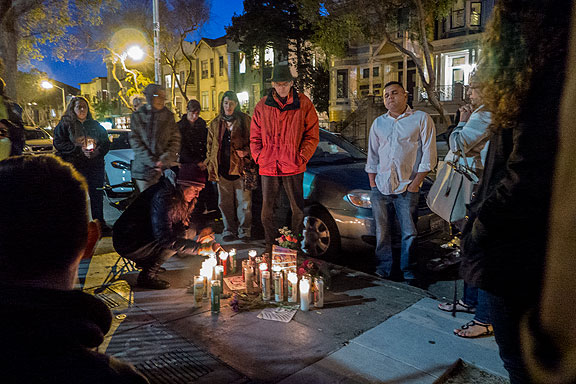
Neighbors hold a vigil on February 28, two days after Guatemalan immigrant and neighbor Amilcar Perez-Lopez was shot dead by an undercover San Francisco cop.
The truth of course is that the vast majority of the victims are murdered out of fear, prejudice, racial animosity, and a well-established military state of mind in which domestic police officers have been taught to see themselves as patrolling enemy territory full of “hostiles.” When there were any “real crimes” involved they more often than not involve minor shoplifting, bus fare evasion, minor drug transactions, or interpersonal disputes. All too often, the victims of police murder are suffering bipolar episodes or other mental illness crises, and rather than working to de-escalate and defuse the situation, or bring mental health professionals in to manage the situation, police respond with anger and violence, further fueling the fear and confusion of the person they ultimately kill (which may in fact lead that person to reasonably fear for their life in the face of armed, threatening police, and cause them to take defensive—sometimes violent—action).
A month ago a young Guatemalan immigrant named Amilcar Perez-Lopez was shot down by plainclothes undercover police across the street from my apartment. He had been trying to recover his cellphone from a man who had been tormenting him and his housemates for the past few weeks. Police came upon the confrontation in which Amilcar had a kitchen knife, ordered him to drop the knife (in English, Amilcar spoke very little English) which he did, and then one of the officers shot five times, hitting Amilcar three times and killing him on the spot, with two bullets whizzing across the street and into the house of a neighbor (just missing hitting their 90-year-old grandmother who sat near the window).
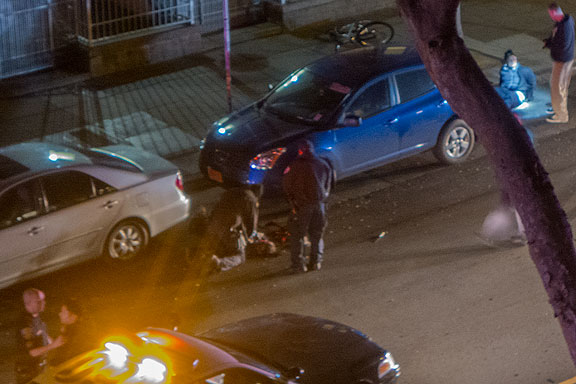
Police over Perez-Lopez’s body, while others are getting their story straight in lower left corner, less than 10 minutes after he was shot.
This is one of dozens of such stories, piling up day in and day out. The impunity of the police is shocking until you realize it’s utterly normal these days. Police killing of unarmed residents is completely normalized, using the technique outlined above. Popular outrage is kept at bay by lying, obfuscating, and delaying, preventing independent investigations, and relying on complicit district attorneys who never file criminal charges against their daily work colleagues, the police. When victims’ families file civil suits for wrongful death or civil rights violations, the cases take years to finish. After several years, when the case is long forgotten by the majority of the population—if they ever knew about it at all—the city agrees to pay some hundreds of thousands, or millions, of dollars in damages to “settle” the case. That money is actually from the taxpayers of course, and the actual perpetrators of the crime, the police, generally go completely unpunished and are patrolling the streets inflicting more mayhem in the years that follow. How long will they get away with it? An explosion of local protests in cities across the U.S. has put police violence and impunity into the spotlight, but so far, except for the Ferguson Missouri resignations, there is little to show for it.
Everyday police violence and impunity is the front line of a larger transformation that has been going on for a while. Tom Engelhardt, a left liberal writer with a popular website, wrote this last week in his essay “The New American Order”:
… we could be watching the birth of a new American political system and way of governing for which, as yet, we have no name. And here’s what I find strange: the evidence of this, however inchoate, is all around us and yet it’s as if we can’t bear to take it in or make sense of it or even say that it might be so.
He is quite a bit more enthralled with the remnants of the democratic form than I am, so I’m going to skip over his criticisms of what has happened to political campaigns and elections, and the delegitimization of the government (all true, but less interesting to me), and the apparent (current) demobilization of popular movements. But he gets to the kleptocratic heart of the matter when he cites James Risen’s recent book, Pay Any Price, where he argues that
… privatization [of the “global war on terror”] has brought something else with it: corruption, scams, and the gaming of the system for profits of a sort that might normally be associated with a typical third-world kleptocracy… Though it’s a subject I know so much less about, this kind of privatization (and the corruption that goes with it) is undoubtedly underway in the non-war-making, non-security-projecting part of the American state as well.
Though it’s seldom pointed out, it should be considered remarkable that in this period we gained a second full-scale “defense department,” the Department of Homeland Security, and that it and the Pentagon have become even more entrenched, each surrounded by its own growing “complex” of private corporations, lobbyists, and allied politicians. The militarization of the country has, in these years, proceeded apace.
Meanwhile, the duplication to be found in the U.S. Intelligence Community with its 17 major agencies and outfits is staggering. Its growing ability to surveil and spy on a global scale, including on its own citizens, puts the totalitarian states of the twentieth century to shame. That the various parts of the national security state can act in just about any fashion without fear of accountability in a court of law is by now too obvious to belabor. As wealth has traveled upwards in American society in ways not seen since the first Gilded Age, so taxpayer dollars have migrated into the national security state in an almost plutocratic fashion.
Meanwhile, across the pond in the UK, writer George Monbiot had a column last week that he called “Hard Graft.” His motivation was a report by Transparency International that has the UK and the US as among the least corrupt places on earth, compared to countries where overt bribery etc. is the norm. But as Monbiot is at pains to note, corruption is so basic to the operations of international banks that the way Transparency International measures corruption is a self-serving scam that helps legitimize the blatant theft at the apex of the system.
…Among the sources used by Transparency International to compile its index are the World Bank and the World Economic Forum. Relying on the World Bank to assess corruption is like asking Vlad the Impaler for an audit of human rights. Run on the principal of one dollar, one vote, controlled by the rich nations while operating in the poor ones, the bank has funded hundreds of white elephant projects that have greatly enriched corrupt elites and foreign capital (17), while evicting local people from their land and leaving their countries with unpayable debts. To general gasps of astonishment, the World Bank’s definition of corruption is so narrowly drawn that it excludes such practices.
The World Economic Forum establishes its corruption rankings through a survey of global executives (18): beneficiaries of the kind of practices I’ve listed in this article. Its questions are limited to the payment of bribes and the corrupt acquisition of public funds by private interests (19), excluding the kinds of corruption that prevail in rich nations. Transparency International’s interviews with ordinary citizens take much the same line: most of its specific questions involve the payment of bribes (20).
…For organisations like the World Bank and the World Economic Forum, there is little difference between the public interest and the interests of global corporations. What might look like corruption from any other perspective looks to them like sound economics. The power of global finance and the immense wealth of the global elite are founded on corruption, and the beneficiaries have an interest in framing the question to excuse themselves…
…Would there still be commercial banking sector in Britain if it weren’t for corruption? Think of the list of scandals: pension mis-selling, endowment mortgage fraud, the payment protection insurance scam, Libor rigging, insider trading and all the rest. Then ask yourself whether fleecing the public is an aberration – or the business model.
Lots of people around San Francisco are quite insistent these days that this economic boom isn’t like the dotcom boom and bust of 1999-2001, or the S&L collapse in the late 1980s, or the Great Depression of the 1930s. When you look at the curve of housing costs against income, and see the insane divergence that has gone on in the 21st century, with wages/salaries flat, and housing prices soaring into the stratosphere, there can be little doubt that this is an unsustainable bubble. But, many object, San Francisco at least is a destination for international investors, so prices will never fall there. The City has allowed more than 10,000 units of luxury housing to be built in the past decade and prices just keep climbing precipitously. There is no apparent supply-and-demand in effect here, at least not yet. I think the answer lies in the “safe deposit box in the sky” argument I cited earlier. Very wealthy people are moving their money into safe havens, especially central city luxury housing in places like San Francisco, New York, Vancouver, London, Paris, etc. These are places where they assume “their property” will be well defended by the ever-more heavily armed police. So far, they’re right. But does anyone really believe this can last indefinitely?
I think a substantial sector of the world’s wealthiest elite recognizes that the gig is almost up. But rather than following a path of intelligent planning and preparation, perhaps even dedicating their resources to working on our shared predicament here on earth, the vast majority of rich people are doubling down on their efforts to grab as much wealth as they can get their hands on. Simultaneously they are trying to build vertical fortresses where they think they can safely enjoy their wealth while the world around them goes to hell. In yet another article from just the past couple of weeks, Andrew Cockburn in Harper’s does a nice job of dissecting the pyramid of theft that CitiCorp has been presiding over since before Obama came to power, but has only accelerated with his complicity in the years since.
Describing the executives who have been gaming the federal government and the banking system during the past decades (and the article gives a very good, detailed history of how CitiCorp came to be, which executives designed this criminal empire and who continues to protect and advance its interests against all odds), Cockburn quotes Arthur Wilmarth, a professor at George Washington University Law School who specializes in banking law.
“These guys are excellent at politics,” Wilmarth told me. “Look at how they persuaded Clinton, Greenspan, and Rubin to do their bidding. But they’re lousy at running their own business.”
This could have been written about the railroad barons of the 19th century (and has been in Richard White’s excellent book, Railroaded). Running through many examples of illegal activities carried out by Citigroup and other major US banks, Wilmarth responds with rare clarity:
“You had systematic fraud at the origination stage,” he told me, “then you had systematic fraud at the securitization stage, then you had systematic fraud at the foreclosure stage. At what point do we consider these institutions to have become effectively criminal enterprises?”
Cockburn leaves us with a cautionary note, perhaps not as fleshed out as it deserves:
Even more troubling is the heavy investment Citigroup, along with JPMorgan and Wells Fargo, has made in collateralized loan obligations—this decade’s C.D.O.’s, which consist of high-yield, high-risk junk bonds sliced into tranches. A high proportion of such junk was issued by energy firms and snapped up in massive quantities by Wall Street largely on the back of the oil-shale boom, now deflating at a precipitous rate. “I think those bonds are already on the edge of the cliff,” says Martens.
Impunity. Police officers on our streets, politicians squandering millions of public dollars on wars and dubious projects of “security” all to funnel wealth to their associated private contractors, bankers who flout common sense and the law but are repeatedly left to continue their practices by bought-and-paid-for politicians and regulators… and on and on. It’s a deeply corrupt kleptocracy running the world. They are all in it for themselves and are stealing everything they can carry as fast as they can get away with it. Everyone knows it can’t last, so the more you can steal and hide now, the more you might have after the coming collapse of this rotten system of organized plunder. Meanwhile, the people most screwed by this are terrorized by militarized police in our cities, and the actual U.S. military in other parts of the world, along with their death squad accomplices in various client militaries.
The hunger for justice is growing. The fantasies that it may be achieved through the utterly corrupted institutions of American “democracy” still hold too many in their thrall. But it can’t last. There is a mighty explosion coming, and it could start any time. Things won’t be the same after it runs its course, that’s for sure.

The People’s Trial of the four officers who shot Alex Nieto 59 times a year ago went off under rainy skies.

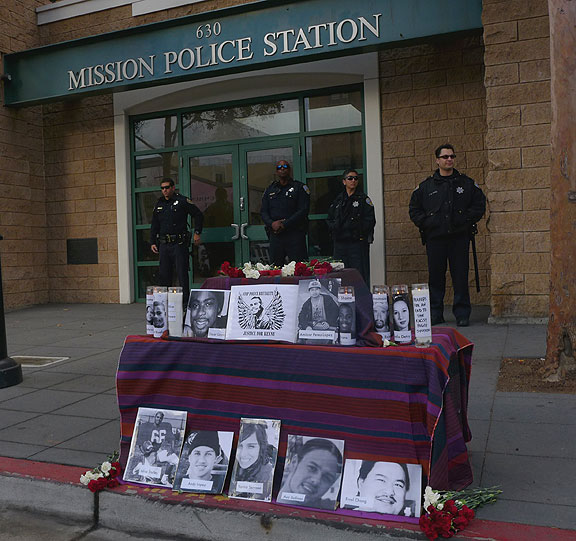
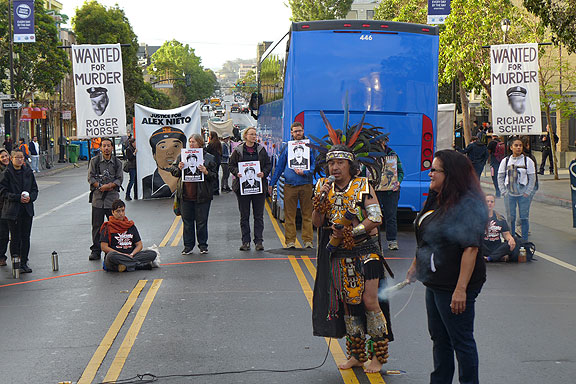
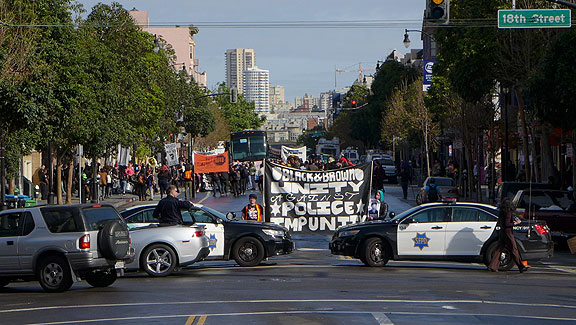











Thanks for that, Chris. You’ve probably seen that book The Rise of the Warrior Cop? Having heard about killings by police for so long I’m still unsure whether they have been increasing or if I’m just more aware of them because of the internet. Your argument (and that book) points to the former and I tend to agree. We gotta disarm those thugs. Then maybe the job will attract people with actual bravery, instead of insecure, racist, trigger-happy bullies…